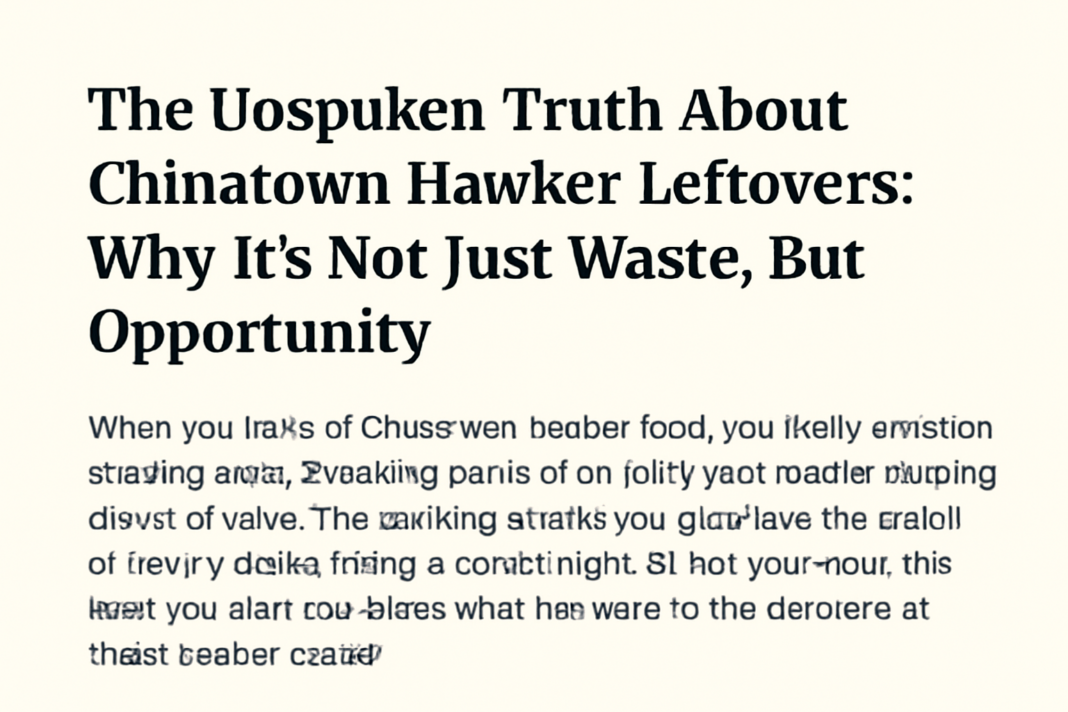Introduction
When you think of Chinatown hawker food, you likely envision sizzling woks, steaming bowls of noodles, and mouthwatering plates of satay. The bustling streets are alive with the smell of savory dishes being prepared right before your eyes. But have you ever wondered what happens to the leftovers at these hawker stalls? In a world where food waste is a growing concern, the idea of leftover food, especially from a popular place like Chinatown, sparks a lot of curiosity. Is it just discarded, or can it be a source of opportunity? In this post, we’ll explore the topic of Chinatown hawker leftovers consumption, from the challenges to the potential benefits, and everything in between.
Why Do Leftovers Happen at Chinatown Hawker Stalls?
If you’ve ever been to Chinatown, you know that the hawker stalls are always packed with eager customers. However, despite the constant stream of patrons, there are still moments when food doesn’t get sold. These leftovers can come from dishes that are overcooked, under-ordered, or simply the result of a busy day when customers just can’t finish their meal.
Food stalls in Chinatown often serve large portions, and in an environment where eating is a social event, customers sometimes order more than they can handle. As a result, leftovers are inevitable. But, rather than simply tossing the extra food away, many hawkers face the dilemma of what to do with it.
The Environmental Impact of Leftovers
Food waste is a serious problem worldwide, and hawker stalls in Chinatown are not immune to it. According to the Food and Agriculture Organization (FAO), about one-third of the food produced globally goes to waste. In places like Chinatown, where food is central to the community, this waste can feel especially wrong. From a local perspective, tossing out leftover food means wasting not only the ingredients but also the labor and energy invested in creating it.
Luckily, there are more and more initiatives designed to reduce this kind of waste. Some hawkers are taking a more thoughtful approach, by using leftovers creatively. Instead of letting food go to waste, they repurpose it in ways that benefit both the community and their businesses.
Creative Uses for Leftover Hawker Food
Repurposing leftover food isn’t just about saving money or reducing waste. It’s also about creating something new and exciting. Many hawkers in Chinatown are finding inventive ways to use their leftovers to create new menu items. For example, leftover rice or noodles might be used as the base for a new stir-fry dish. Leftover meats could be combined with fresh vegetables to create hearty soups or sandwiches.
Another interesting practice is the “hawker box,” where leftover food from multiple stalls is combined into a single meal, offering a diverse range of tastes at a lower cost. This not only helps reduce waste but also introduces customers to different flavors they might not have tried otherwise.
The Rise of “Food Rescue” in Chinatown
In addition to creative reusing of leftovers by hawkers themselves, there’s also the growing movement of “food rescue” organizations. These groups work with restaurants, hawker stalls, and food producers to collect unsold food that would otherwise go to waste. The food is then distributed to those in need, or sold at a discounted price to reduce its environmental impact.
In Chinatown, food rescue organizations are helping connect hawker stalls with communities in need. By rescuing perfectly good, though unsold, food, these organizations can redistribute it to local shelters, food banks, and other community initiatives. This not only reduces waste but also provides nourishment to those who might not have access to fresh meals.
Challenges to Leftover Consumption at Chinatown Hawker Stalls
While the idea of repurposing or redistributing leftover food sounds appealing, it’s not without its challenges. First, there are health and safety regulations that prevent hawkers from simply giving away or reselling leftover food. For example, hygiene standards in many countries require food to be consumed or discarded within a certain time frame to prevent contamination.
Moreover, customers may not always be open to the idea of eating leftover food, as there is often a stigma attached to it. People might be concerned about the freshness or quality of food that’s been sitting around, even if it’s still perfectly good. Convincing the public that food waste isn’t the only option can be a difficult task for hawkers.
The Benefits of Leftover Consumption
Despite the challenges, there are plenty of benefits to consuming or repurposing Chinatown hawker leftovers. For starters, it helps reduce food waste and supports a more sustainable food system. Repurposing food also allows hawkers to keep their prices low, which is particularly important in the competitive food scene of Chinatown.
Additionally, consuming leftover food can help customers save money. Many people are willing to buy leftover food at a lower price, which provides an affordable option for those on a budget. For hawkers, this can translate into a loyal customer base who appreciate the value they’re getting.
Conclusion
Chinatown hawker leftovers consumption is more than just a question of food waste; it’s an opportunity to rethink how we approach food in our communities. From creative repurposing to food rescue initiatives, there are many ways to tackle this issue that benefit both the environment and local communities. While there are certainly challenges, the potential rewards make it an important area to explore. By embracing a culture of leftover consumption, Chinatown hawkers can play a pivotal role in reducing waste, supporting those in need, and making a positive impact on the local food economy.



